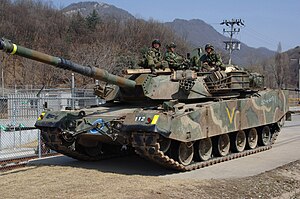K1A1
| K1 | |
|---|---|

K1
|
|
| Type | Main battle tank |
| Place of origin | South Korea |
| Service history | |
| In service | K1: 1987–present K1E1: 2014–present K1A1: 2001–present K1A2: 2013–present |
| Used by | See operators |
| Production history | |
| Designer | Chrysler Defense General Dynamics Hyundai Rotem |
| Manufacturer | Hyundai Rotem |
| Unit cost | K1: ₩2,500,000,000 K1A1: ₩4,400,000,000 (approx 4,030,853 USD) |
| Produced | K1: 1985–1998 K1E1: 2013–present K1A1: 1999–2010 K1A2: 2012–present |
| No. built | K1/E1: 1,027 K1A1/A2: 484 |
| Specifications | |
| Weight | K1: 51.1 metric tons (56.3 short tons) K1A1: 53.2 metric tons |
| Length | K1: 9.67 m K1A1: 9.71 m |
| Width | 3.60 m |
| Height | 2.25 m |
| Crew | 4 (commander, gunner, loader and driver) |
|
|
|
| Armor | Special Armour Plate (SAP) Korean Special Armour Plate (KSAP) |
|
Main
armament |
K1: KM68A1 105 mm (47 rounds) K1A1: KM256 120mm (32 rounds) |
|
Secondary
armament |
12.7 mm K6 HMG on right pintle mount for commander 7.62 mm M60D on left pintle mount for loader 7.62 mm M60E2-1 on coaxial mount |
| Engine | 8-cyl. water-cooled diesel MTU 871 Ka-501 1200 hp (890 kW) at 2600 rpm |
| Power/weight | K1: 23.4 hp/ton K1A1: 22.0 hp/ton |
| Transmission | ZF LSG 3000 (four forward, two reverse) |
| Suspension | Hydropneumatic at front and rear, torsion bar at middle of the chassis |
|
Operational
range |
500 km |
| Speed | 65 km/h (road) 40 km/h (cross country) |
The K1 is a South Korean main battle tank in use with the Republic of Korea Armed Forces, developed by Hyundai Precision (later Hyundai Rotem). The vehicle's early design work was based on General Dynamics' M1 Abrams, with some noticeable differences including a combined system of hydropneumatic suspension and torsion bars, and a river-crossing fording kit, to meet the required operational capability that was specific to combat operations in the mountainous and swampy terrain of the Korean Peninsula. The K1A1 entered service in 1999, upgraded with a 120mm smoothbore gun, and outfitted with more modern electronics, ballistic computers, and fire control systems developed by Samsung Electronics. Hyundai Rotem produced 1,511 K1 and K1A1 tanks between 1985 and 2010.
In the 1970s, the Republic of Korea was desperately in need of additional main battle tanks. The M4A3E8 "Easy Eight" variant of Sherman tanks, dating back to World War II, had been retired from service by the Republic of Korea Army, and the backbone of the South Korean armor was formed up of M47 and M48 Patton tanks. Meanwhile, North Koreans had both numerical and technological advantages over the South Korean armor with their T-62 main battle tanks.
At first, attempts were made to obtain the United States' M60A1 Pattons, but they ended in failure. It was deemed that, even if the M60A1s were obtainable, there would not be enough of them to give the South Korean forces a significant advantage over existing North Korean tanks. A number of other plans were also devised, such as upgrading the existing M48 Pattons to the M48A3 and A5 standard, as well as obtaining the license to domestically produce Germany's Leopard 1 main battle tank. Only the upgrades to the Pattons were carried out, with the results being the M48A3K and M48A5K, while producing Leopard 1s was deemed counterproductive, as a newer generation of main battle tanks were already being developed and tested in both the U.S. and Germany, namely the M1 Abrams and Leopard 2.
...
Wikipedia
